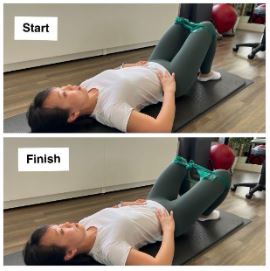Is Back Pain Holding You Back?
Discover a Path to Recovery and Strength through Clinical Pilates.
Have you had a recent back injury? Have you been attending physiotherapy for your injury and now want to get back to moving better and feeling stronger again? Has your back pain resolved but you aren’t feeling ready to return to the pickleball court or the hockey rink? Patients often ask how can Clinical Pilates help with their current back problem, and the answer is it can help in many ways!
All of our physiotherapists that offer Clinical Pilates have taken extensive training to apply the principles of pilates as an active treatment approach to help improve the way your body moves with strength and length. It begins with a proper assessment to identify areas of movement dysfunction (ie. Is a muscle tight and/or weak? Are there joints or areas of the body that are stiff and restricted? Are the muscles that control certain movement patterns activating in the correct sequence? Is there an imbalance in the muscles around a specific joint or body part?). Information from the assessment helps your clinician come up with a treatment plan designed to improve the way you move and help you reach your functional goals.
When there is an injury to the back, the body tries to protect that area and uses non-optimal movement strategies while the injury is healing. Some of these compensation patterns include: 1) the ‘larger’ muscles might start to grip and take on the role of the smaller stabilizing muscles of the back, 2) there may be too little or too much movement above or below an injury, or 3) there may be an incorrect pattern of movement during a specific task at home, work or sport. This then leads to perceived weakness and instability in the spine, and also tightness around the back, hips and pelvis. With guided exercise, your clinician can help you re-learn how to use a more optimal pattern of muscle activity to improve strength and mobility of your back.
Here are a few of my favourite exercises to get you started with activating muscles to provide stability to your back.
Bent leg lifts
- Lie on your back with your knees bent and feet flat on the floor. Maintain a hips distance between both knees and feet.
- Exhale and tighten your abdominal muscles. Gently flatten your low back towards the floor.
- Slowly raise one leg, keeping your knee bent at 90 degrees. Inhale holding this position, then exhale and lower your leg back down to the floor. Repeat up to 10x alternating legs with proper technique.
- Do not twist or arch your trunk.
Bent Knee Fall Outs (with band)
- Lie on your back with your knees bent and your feet flat on the floor. Tie an exercise band around both knees
- Gently tighten your core muscles before slowly dropping your stronger leg out to the side, pulling against the band.
- The weaker leg should remain still
- Keep your core muscles working while you bring your knee back up to the starting position.
- Do not allow your pelvis to rotate during this movement. Repeat up to 10x alternating legs.
Pallof Press
- Stand up straight with a resistance band tied to one side.
- Hold the other end of the resistance band in both hands around the height of your belly button, and pick up the tension.
- Keep your posture up straight, and your legs hips width apart with a slight bend in your knees.
- Maintaining this posture, steadily move your hands directly forwards, straightening your elbows out. The band will try to rotate your body around. Use the strength in your abdominal muscles to resist this movement.
- Control the movement as you bend your arms, bringing your hands back in to your body.
- Repeat up to 10x with proper technique. Repeat on the other side.
By: Christina Eng (Registered Physiotherapist and Certified Pilates Instructor)






